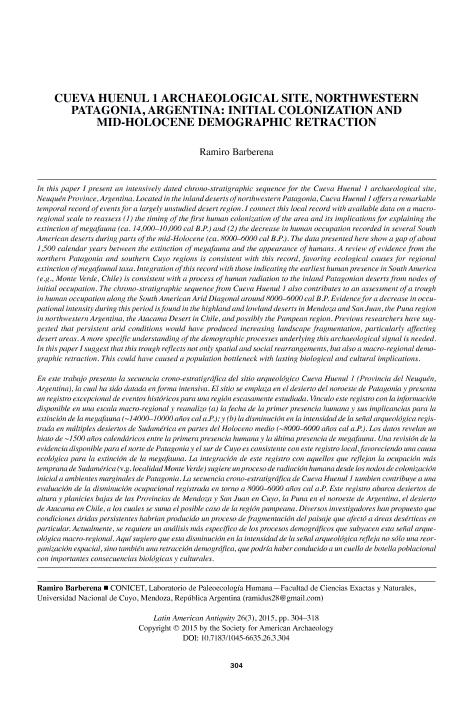Mostrar el registro sencillo del ítem
dc.contributor.author
Barberena, Ramiro

dc.date.available
2018-09-14T18:01:02Z
dc.date.issued
2015-09
dc.identifier.citation
Barberena, Ramiro; Cueva huenul 1 archaeological site, Northwestern patagonia, Argentina: Initial colonization and mid-holocene demographic retraction; Society for American Archaeology; Latin American Antiquity; 26; 3; 9-2015; 304-318
dc.identifier.issn
1045-6635
dc.identifier.uri
http://hdl.handle.net/11336/59720
dc.description.abstract
In this paper I present an intensively dated chrono-stratigraphic sequence for the Cueva Huenul 1 archaeological site, Neuquén Province, Argentina. Located in the inland deserts of northwestern Patagonia, Cueva Huenul 1 offers a remarkable temporal record of events for a largely unstudied desert region. I connect this local record with available data on a macroregional scale to reassess (1) the timing of the first human colonization of the area and its implications for explaining the extinction of megafauna (ca. 14, 000-10, 000 cal B.P.) and (2) the decrease in human occupation recorded in several South American deserts during parts of the mid-Holocene (ca. 8000-6000 cal B.P.). The data presented here show a gap of about 1, 500 calendar years between the extinction of megafauna and the appearance of humans. A review of evidence from the northern Patagonia and southern Cuyo regions is consistent with this record, favoring ecological causes for regional extinction of megafaunal taxa. Integration of this record with those indicating the earliest human presence in South America (e.g., Monte Verde, Chile) is consistent with a process of human radiation to the inland Patagonian deserts from nodes of initial occupation. The chrono-stratigraphic sequence from Cueva Huenul 1 also contributes to an assessment of a trough in human occupation along the South American Arid Diagonal around 8000-6000 cal B.P. Evidence for a decrease in occupational intensity during this period is found in the highland and lowland deserts in Mendoza and San Juan, the Puna region in northwestern Argentina, the Atacama Desert in Chile, and possibly the Pampean region. Previous researchers have suggested that persistent arid conditions would have produced increasing landscape fragmentation, particularly affecting desert areas. A more specific understanding of the demographic processes underlying this archaeological signal is needed. In this paper I suggest that this trough reflects not only spatial and social rearrangements, but also a macro-regional demographic retraction. This could have caused a population bottleneck with lasting biological and cultural implications.
dc.format
application/pdf
dc.language.iso
eng
dc.publisher
Society for American Archaeology
dc.rights
info:eu-repo/semantics/openAccess
dc.rights.uri
https://creativecommons.org/licenses/by-nc-sa/2.5/ar/
dc.subject
Poblamiento Temprano
dc.subject
Extincion de La Megafauna
dc.subject
Discontinuidades Poblacionales
dc.subject
Cuellos de Botella
dc.subject.classification
Historia

dc.subject.classification
Historia y Arqueología

dc.subject.classification
HUMANIDADES

dc.title
Cueva huenul 1 archaeological site, Northwestern patagonia, Argentina: Initial colonization and mid-holocene demographic retraction
dc.type
info:eu-repo/semantics/article
dc.type
info:ar-repo/semantics/artículo
dc.type
info:eu-repo/semantics/publishedVersion
dc.date.updated
2018-09-14T14:13:38Z
dc.journal.volume
26
dc.journal.number
3
dc.journal.pagination
304-318
dc.journal.pais
Estados Unidos

dc.journal.ciudad
Nueva York
dc.description.fil
Fil: Barberena, Ramiro. Consejo Nacional de Investigaciones Científicas y Técnicas; Argentina. Universidad Nacional de Cuyo. Facultad de Ciencias Exactas y Naturales. Laboratorio de Paleoecología Humana; Argentina
dc.journal.title
Latin American Antiquity
dc.relation.alternativeid
info:eu-repo/semantics/altIdentifier/doi/https://doi.org/10.7183/1045-6635.26.3.304
dc.relation.alternativeid
info:eu-repo/semantics/altIdentifier/url/https://www.cambridge.org/core/journals/latin-american-antiquity/article/cueva-huenul-1-archaeological-site-northwestern-patagonia-argentina-initial-colonization-and-midholocene-demographic-retraction/5E82F8834F41086EEAC279D3738A5228
Archivos asociados
